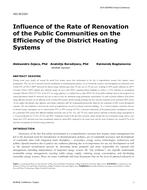Description
During recent years, people all around the world have become aware that environment in the city is comprehensive resource that requires smart management. This has led to increased need for introduction of decarbonization policies, use of sustainable resources and development of sustainable cities. Section 431 of EISA 2007 increased the federal energy reduction goal from 2% per year to 3% per year, resulting in 30% greater efficiency by 2015. Executive Order 13693 adopted new reduction targets for years after 2015, requiring federal buildings to achieve a 2.5% reduction in consumption annually. Directive 2012/27/EU of the EU on energy efficiency it is defined that as from 2014 3% of the public buildings owned and occupied by its central government should be renovated each year to meet at least the minimum energy performance requirements. In order to predict influence of the future energy efficiency measures on the efficiency of the existing DH systems, district heating planning tool was used for evaluation of the particular DH system. At the output tool provides nine efficiency and balance indicators with the recommended permissible limits for the evaluation of DH system development scenarios. The tool validation is based on the results of comprehensive research of already renovated buildings. As a result of complex renovation decrease in thermal energy consumption can be achieved from 35% to 50% (average 42.3%). Consistent simulations of the proposed future development scenarios for a particular DH system with different building renovation rates of 3%, 5%, and 7% have shown natural reduction in thermal energy consumption in a 15-year perspective by 13.5%, 22.5% and 30%. Simulation results of the last three scenarios, which consider the use of renewable energy sources, have shown that CO2 emissions have been considerably reduced by about 40% compared to the actual state and the share of biomass has reached 47% of the total fuel consumption for thermal energy production.
Citation: 2018 Annual Conference, Houston, TX, Conference Papers
Product Details
- Published:
- 2018
- Number of Pages:
- 9
- Units of Measure:
- Dual
- File Size:
- 1 file , 830 KB
- Product Code(s):
- D-HO-18-C031




